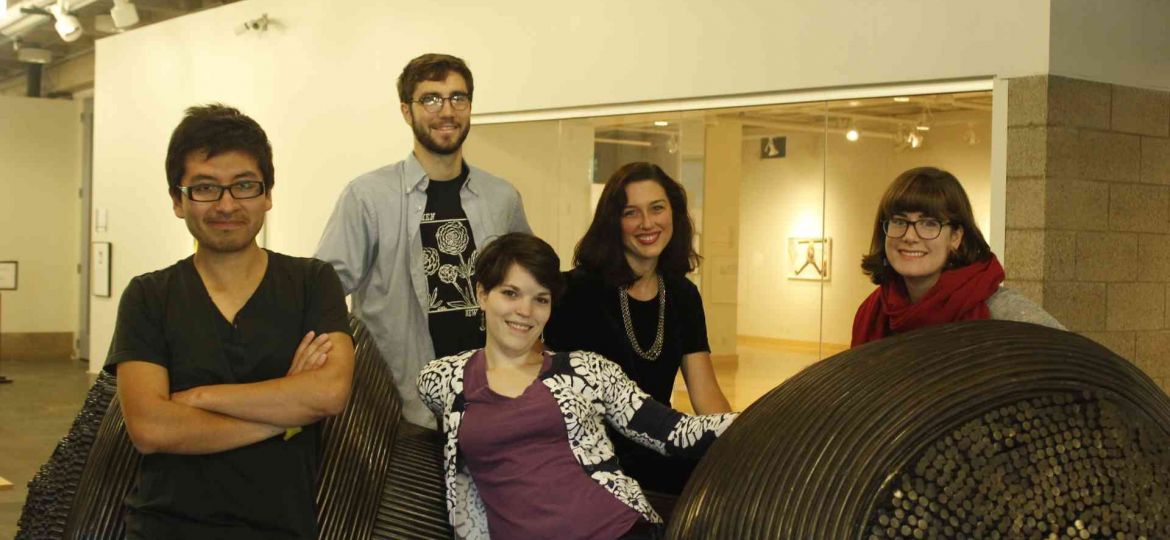
St. Olaf is a pretty awesome place, right? Who wouldn’t want to stay around for a fifth year? If you are Madeline Berger ’14, Isaac Burton ’14, Juan Fernando Yanqui Rivera ’14, Madeleine Senko ’14 and Caroline Wood ’14, then you get to do just that. They are the 2014-2015 art apprentices participating in a program that allows them to spend a year after graduation focusing on their artwork before moving on to graduate school or a career.
“It’s difficult to come out of college with your own studio and get an exhibition,” Rivera said. “The program provides the validation of an institution.”
After completing a competitive application process and being accepted to the program, these five students live and work off campus but get to utilize the space and opportunities of Dittmann Center to continue making their art. In addition, they serve as mentors to underclassmen, receive a stipend of up to $1,000 a year and participate in exhibitions in January at St. Olaf and in April at the Northfield Arts Guild with art interns from Carleton.
“It’s a wonderful transition year between the rigors of college and the reality of life after college,” said Professor John Saurer, chair of the program.
The art apprenticeship program has been around for about 35 years. It was founded by Arch Leean, a member of the St. Olaf art department faculty. It used to be funded by the college, and only one or two students would be able to stay for a fifth year. The program appeared to be doomed when the college pulled its funding, but then alumnus of the art department and Minneapolis businessman Steve Carpenter ’82 stepped up and funded it for 30 years. Currently, the program is supported by an endowment fund put together by Wendell Arneson, senior member of the department.
So who is an ideal art apprentice? According to Saurer, the ideal art apprentice is “somebody who, by the time they hit spring of senior year and in senior studies, has a certain amount of clarity, excitement and momentum with their artwork conceptually, technically, and formally. There are cases where there is a student who didn’t struggle but didn’t have all the clarity, yet they continue making work and something happens in their final term. We see this great potential sort of blossom and we take the gamble that they need to continue in this vein of work with that momentum of creativity.”
The 2014-2015 art apprentices certainly meet these criteria, and they have big plans for the year. Wood’s main medium is photography, but she is also challenging herself with development of a film she shot over the summer, bookmaking, printmaking and integration of those into her photography.
“I’m really interested in history and the history of places – my senior project was about Russia and I spent the summer in rural Wisconsin. I might consider pursuing that with art or the history of art. I’m not sure where that’s going yet, but that’s what I like to do,” Wood said.
“The goal for me is to make art,” Senko said. “I’m hoping to produce a lot of art, more than I could possibly put in the two shows. I hope to develop some of the skills I already have, like printmaking. I haven’t done this in two years, but I want to keep printing while I have facilities. A big part of [the program] is working with Jane [Becker-Nelson, director of Flaten Art Museum], because I have a strong interest in museums. I’m also making sure I stay fed, too. No concrete plans yet!”
Rivera is exploring synesthesia and museums with his art.
“Art can be real exclusive. If you’re blind and want to see Picasso your experience is different because you don’t have the means to appreciate his work. When I create pieces they’re more accessible to people. You can experience an object through different experiences and aesthetics.” If you are a senior art major, this program could be perfect for you.
“You can paint and draw in a garage or at home, but to have some of these more technically intensive mediums, having access to a building as well-appointed as Dittmann is really important,” Saurer said. “The biggest gift is their invitation to stay around and use the facility and to remain active in the department.”
This year’s art apprentices have accomplished a lot thus far, but they still have huge hopes and dreams, ranging from graduate school to bread-making in Paraguay. The art apprenticeship program has helped many students actualize these dreams, and will certainly continue to do so.
walker1@stolaf.edu
Photo Credit: VALENTINA YANG/MANITOU MESSENGER

